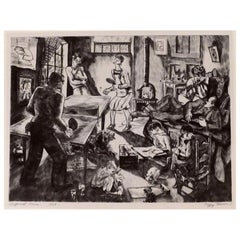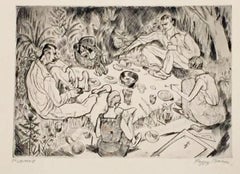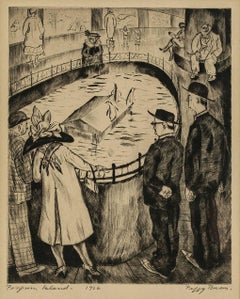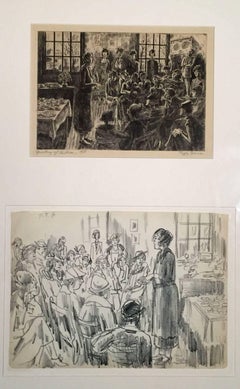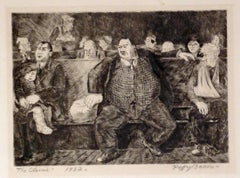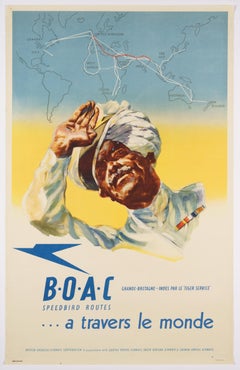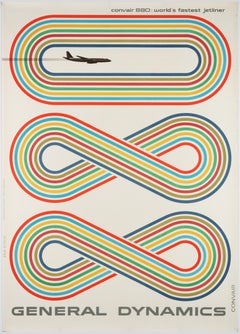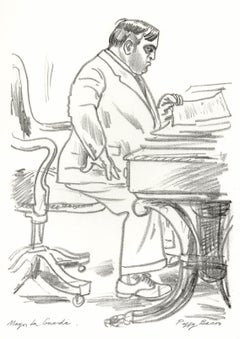Peggy Bacon Figurative Prints
to
3
4
Overall Width
to
Overall Height
to
3
8
859
382
378
308
7
1
4
2
5
2
6
5
4
4
2
1
1
1
4
4
3
1
7
Artist: Peggy Bacon
Peggy Bacon Pencil Signed Etching, 1929 - Congenial Scene
By Peggy Bacon
Located in Phoenix, AZ
Peggy Bacon original etching and drypoint created 1929. Pencil signed lower right.
Titled “Congenial Scene.” Image measures 9"h x 11 7/8"w. In excellent condition.
Matted and unframe...
Category
1920s Peggy Bacon Figurative Prints
Materials
Paper
PICNIC
By Peggy Bacon
Located in Portland, ME
Bacon, Peggy. PICNIC.
Drypoint, 1926.
Titled and signed in pencil.
5 7/8 x 8 3/8 inches.
Printed on laid paper with deckle on four sides. Very faint matstain, else in excellent c...
Category
1920s Peggy Bacon Figurative Prints
Materials
Drypoint
$2,250
Drypoint Etching "Penguin Island" 1926
By Peggy Bacon
Located in Surfside, FL
Margaret Frances "Peggy" Bacon (May 2, 1895 – January 4, 1987) was an American printmaker, illustrator, painter and writer. Bacon was known for her humorous and ironic etchings and drawings, as well as for her satirical caricatures of prominent personalities in the late 1920s and 1930s. Bacon's parents were both artists and met while attending the Art Students League in New York. At the end of 1913, Bacon first studied art at the School of Applied Design for Women but disliked it calling it, "the prissiest, silliest place that ever was." She transferred after a few weeks to the School of Fine and Applied Arts on the West Wide where she took classes in illustration and life drawing. During the summer of 1914 Bacon attended Jonas Lie's landscape class in Port Jefferson, Long Island.
From 1915-1920 Bacon studied painting with Kenneth Hayes Miller, John Sloan, George Bellows and others at the Art Students League. While at the League, Bacon became friends with several other artists. Her circle of friends and acquaintances included Dorothea Schwarz (Greenbaum), Anne Rector (Duffy), Betty Burroughs (Woodhouse), Katherine Schmidt (Kuniyoshi Shubert), Yasuo Kuniyoshi, Molly Luce...
Category
1920s Modern Peggy Bacon Figurative Prints
Materials
Drypoint, Etching
SPEAKING OF CHILDREN and PTA FRIEND'S SEMINARY
By Peggy Bacon
Located in Portland, ME
Bacon, Peggy. SPEAKING OF CHILDREN and PTA FRIEND'S SEMINARY. Flint 120. Etching, 1933, together with a preparatory drawing, titled "PTA Friend's Seminary." The etching titled, dated an signed in pencil. The edition size is not known, but likely small as the print is uncommon; there are no auction...
Category
1930s American Modern Peggy Bacon Figurative Prints
Materials
Etching
HATTY
By Peggy Bacon
Located in Portland, ME
Bacon, Peggy.
HATTY. Flint 48. Drypoint, 1921.
Titled, signed and dated in pencil.
5 1/2 x 8 7/16 inches (plate), 9 5/16 x 12 1/2 inches (sheet).
In excellent condition.
"A rest...
Category
1920s Peggy Bacon Figurative Prints
Materials
Etching
$2,250
THE CLINIC
By Peggy Bacon
Located in Portland, ME
Bacon, Peggy. THE CLINIC. Flint 109. Drypoint, 1932. Edition size not known, but likely very small as the print is rare. 4 15/16 x 6 7/8 inches, plus wide margins (the sheet is 11 x ...
Category
1930s American Modern Peggy Bacon Figurative Prints
Materials
Drypoint
ICE CREAM
By Peggy Bacon
Located in Portland, ME
Bacon, Peggy (American, 1895-1987).
ICE CREAM. Flint 6.
Drypoint, 1918.
Edition size not known, but likely very small.
Titled "Ice Cream," dated "Nov. 19...
Category
1910s Peggy Bacon Figurative Prints
Materials
Drypoint
$2,500
Related Items
BOAC Speedbird Routes Across the World – Original Vintage British Airline Poster
By Harold Foster
Located in Zurich, CH
Original Vintage Airline Poster by Harold Foster. He created several designs commissioned by the British Overseas Airways Corporation ...
Category
Mid-20th Century Peggy Bacon Figurative Prints
Materials
Paper
$2,300
H 39.97 in W 25.01 in D 0.04 in
General Dynamics, Convair 880, World's Fastest Jetliner – Original Poster
By Erik Nitsche
Located in Zurich, CH
A poster belonging to Erik Nitsche's third series for General Dynamics, promoting its Convair Company.
Founded 1952, General Dynamics hired Nitsche a...
Category
Mid-20th Century Modern Peggy Bacon Figurative Prints
Materials
Paper
$7,100
H 50.4 in W 35.44 in D 0.04 in
Les Musiciennes – lithograph, hand-signed and numbered
By Le Corbusier
Located in Zurich, CH
Together with "Bouteilles" one of the largest and most sought after lithographs by Le Corbusier, printed by Mourlot on Arches after a collage by LC....
Category
Mid-20th Century Modern Peggy Bacon Figurative Prints
Materials
Paper
$39,300
H 26.78 in W 38.59 in D 0.04 in
Chicago Skyline
By Paul Schumann
Located in Middletown, NY
A beautiful turn-of-the-century lake view of Chicago by an American artist known for his Texas landscapes.
Etching with drypoint on watermarked Umbria laid paper with deckle edges, 7 1/4 x 10 7/8 inches (182 x 275 mm), full margins. Signed and numbered 4/25 in pencil, lower margin. In good condition with adhesive residue at the sheet edges on the verso, does not show through to the recto. A lovely Lake Michigan landscape...
Category
Early 20th Century American Modern Peggy Bacon Figurative Prints
Materials
Handmade Paper, Etching, Drypoint
Original Vintage Secession Poster celebrating the emperor's jubilee
Located in Zurich, CH
Original Vintage Poster by the Austrian artist Ferdinand Ludwig Graf, a member of the Hagenbund. This Viennese artist association moved as soon a...
Category
Early 1900s Vienna Secession Peggy Bacon Figurative Prints
Materials
Paper
$13,700
H 48.82 in W 36.42 in D 0.04 in
Cortland Street
Located in Middletown, NY
Etching with drypoint on antique handmade laid Japon paper, 12 7/8 x 7 1/2 (327 x 191 mm); sheet 15 5/16 x 10 7/16 (389 x 265 mm), full margins. Signed in pencil in the lower margin....
Category
Early 20th Century American Modern Peggy Bacon Figurative Prints
Materials
Etching, Drypoint
Steps to the Grand Canal, St. Mark's in the distance, Venice.
By Donald Shaw MacLaughlan
Located in Middletown, NY
A lovely view of Venice from the water.
Etching with drypoint on antique cream laid paper with a large figural watermark, signed in pencil, lower right. 14 1/4 x 11 inches (362 x 280...
Category
Early 20th Century American Modern Peggy Bacon Figurative Prints
Materials
Laid Paper, Drypoint, Etching
Low Country (South Carolina)
By Elizabeth Verner
Located in Middletown, NY
An enchanting Southern landscape by the mother of the Charleston Renaissance.
A native of Charleston, South Carolina, and educated under the tutelage of Thomas Anshutz at The Pennsylvania Academy of Fine Arts, O'Neill Verner was a teacher, a mother, an artist, an ardent preservationist, and a skilled autodidact. Having previously focused on painting, in the early 1920s she found herself deeply moved by printmaking as a media, and especially so by the simple, peaceful themes and tableaus she discovered in Japanese art. She embarked on a effort to teach herself Japanese printmaking techniques, and in the process, produced the charming images of every day life in Charleston and its environs that earned her recognition as a cultural icon in her day, and in more modern times, as the mother of the Charleston Renaissance, which flourished well into the 1930s. In 1923 she opened a studio in Charleston where she focused on documenting the local color and the architecture and landscape that distinguishes Charleston as one of the South's most beautiful cities, all the while applying the gentle and poetic thematic sensibilities of Japanese printmaking. O'Neill Verner soon found herself in high demand when municipalities and institutions throughout the country sought commissions from her to document the beauty of their grounds and historic buildings. She worked as far north as the campuses of Harvard and Princeton, and extensively across the South, including in Savannah, Georgia, where through sweeping commissions she was able to marry her love of southern preservation and art. O'Neill Verner was a lifelong learner, and continued a path of edification that led her to study etching at the Central School of Art in London, to travel extensively through Europe, and to visit Japan in 1937, where she studied sumi (brush and ink) painting. She was a founding member of the Charleston Etchers Club, and the Southern States Art League. Her works are represented in the permanent collections of leading museums across the American south, and in major national institutions including the Metropolitan Museum of Art, Boston's Museum of Fine Art, and the Smithsonian American Art Museum. O'Neil Verner...
Category
Early 20th Century American Modern Peggy Bacon Figurative Prints
Materials
Archival Paper, Drypoint, Etching
Grand Tier and the Met
By Reginald Marsh
Located in Fairlawn, OH
Grand Tier at the Met
Etching, 1939
From: Reginald Marsh, Thirty Etchings and Engravings
Published by the Whitney Museum of American Art, 1969
Unsigned (as usual for the Whitney edit...
Category
1930s American Modern Peggy Bacon Figurative Prints
Materials
Etching
Icart, Sans titre, Le Sopha (after)
By Louis Icart
Located in Southampton, NY
La pointe sèche etching on vélin de Rives filigrané à notre nom paper. Paper size: 9.5 x 7.5 inches; image size: 6.5 x 4.5 inches. Inscription: unsigned and unnumbered, as issued. No...
Category
1930s Modern Peggy Bacon Figurative Prints
Materials
Drypoint, Etching
Icart, Sans titre, Le Sopha (after)
By Louis Icart
Located in Southampton, NY
La pointe sèche etching on vélin de Rives filigrané à notre nom paper. Paper size: 9.5 x 7.5 inches; image size: 6.5 x 4.5 inches. Inscription: unsigned and unnumbered, as issued. No...
Category
1930s Modern Peggy Bacon Figurative Prints
Materials
Drypoint, Etching
Le Colosse
By Salvador Dalí
Located in New York, NY
Color drypoint. Signed by the artist in pencil lower right. Numbered 44/100 in pencil lower left. Published by Editions d'Art de Francony, Paris.
Catalogue raisonne reference: Fi...
Category
1970s Surrealist Peggy Bacon Figurative Prints
Materials
Drypoint
Previously Available Items
LaGuardia (Fiorella LaGuardia, GOP Mayor of NYC 1934-1945)
By Peggy Bacon
Located in New Orleans, LA
The subject of this 1934 lithographic portrait is Mayor Fiorella LaGuardia who was irascible, energetic and charismatic and acclaimed as one of America's great Mayors. Only 5ft 2in tall, La Guardia...
Category
1930s American Realist Peggy Bacon Figurative Prints
Materials
Lithograph
Drypoint Etching "Penguin Island" 1926
By Peggy Bacon
Located in Surfside, FL
Margaret Frances "Peggy" Bacon (May 2, 1895 – January 4, 1987) was an American printmaker, illustrator, painter and writer. Bacon was known for her humorous and ironic etchings and drawings, as well as for her satirical caricatures of prominent personalities in the late 1920s and 1930s. Bacon's parents were both artists and met while attending the Art Students League in New York. At the end of 1913, Bacon first studied art at the School of Applied Design for Women but disliked it calling it, "the prissiest, silliest place that ever was." She transferred after a few weeks to the School of Fine and Applied Arts on the West Wide where she took classes in illustration and life drawing. During the summer of 1914 Bacon attended Jonas Lie's landscape class in Port Jefferson, Long Island.
From 1915-1920 Bacon studied painting with Kenneth Hayes Miller, John Sloan, George Bellows and others at the Art Students League. While at the League, Bacon became friends with several other artists. Her circle of friends and acquaintances included Dorothea Schwarz (Greenbaum), Anne Rector (Duffy), Betty Burroughs (Woodhouse), Katherine Schmidt (Kuniyoshi Shubert), Yasuo Kuniyoshi, Molly Luce...
Category
1920s Modern Peggy Bacon Figurative Prints
Materials
Drypoint, Etching
Peggy Bacon figurative prints for sale on 1stDibs.
Find a wide variety of authentic Peggy Bacon figurative prints available for sale on 1stDibs. You can also browse by medium to find art by Peggy Bacon in drypoint, engraving, etching and more. Much of the original work by this artist or collective was created during the 20th century and is mostly associated with the modern style. Not every interior allows for large Peggy Bacon figurative prints, so small editions measuring 12 inches across are available. Customers who are interested in this artist might also find the work of Isabel Bishop, Kerr Eby, and John French Sloan. Peggy Bacon figurative prints prices can differ depending upon medium, time period and other attributes. On 1stDibs, the price for these items starts at $2,000 and tops out at $3,750, while the average work can sell for $2,400.
